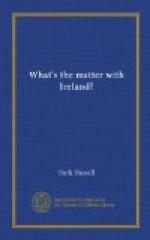Then gentle Mrs. Gallagher, conscious of a benevolent force close at hand, began simply:
“Well, don’t you think perhaps—”
[Footnote 1. “To the Masters of Dublin—An Open Letter.” By AE. The Irish Times, Oct. 17, 1913.]
V
THE CATHOLIC CHURCH AND COMMUNISM
THE LIMERICK SOVIET
A soviet supported by the Catholic Church—that was the singular spectacle I found when I broke through the military cordon about the proclaimed city of Limerick.
The city had been proclaimed for this reason: Robert Byrne, son of a Limerick business man, had been imprisoned for political reasons. He fell ill from the effects of a hunger strike,[1] and was sent to the hospital in the Limerick workhouse. A “rescue party” was formed. In the melee that followed, Robert Byrne and a constable were killed. Then according to a military order, Limerick was proclaimed because of “the attack by armed men on police constables and the brutal murder of one of them.”
At Limerick Junction we were locked in our compartments. There were few on the train. Two or three school boys with their initialed school caps. Two or three women drinking tea from the wicker train baskets supplied at the junction. In the yards of the Limerick station, the train came to a dead stop. Then the conductor unlocked compartments, while a kilted Scotch officer, with three bayonet-carrying soldiers behind him, asked for permits. At last we were pulled into the station filled with empty freight trucks and its guard of soldiers. Through the dusk beyond the rain was slithering.
“Sorry. No cab, miss,” said a constable. “The whole city’s on strike.”
That explained my inability to get Limerick on the wire. From Kildare I had been trying all morning to reach Limerick on the telephone. All the Limerick shops I passed were blinded or shuttered. In the gray light, black lines of people moved desolately up and down, not allowed to congregate and apparently not wanting to remain in homes they were weary of. A few candles flickered in windows. After leaving my suitcase at a hotel, I left for the strike headquarters. On my way I neared Sarsfield bridge. Between it and me, there loomed a great black mass. Close to it, I found it was a tank, stenciled with the name of Scotch-and-Soda, and surrounded by massed barbed wire inside a wooden fence. On the bridge, the guards paraded up and down and called to the people:
“Step to the road!”
At the door of a river street house, I mounted gritty stone steps. A red-badged man opened the door part way. As soon as I told him I was an American journalist, the suspicious look on his face vanished. With much cordiality he invited me to come upstairs. While he knocked on a consultation door, he bade me wait. In the wavering hall light, the knots in the worn wooden floor threw blots of shadow. On an invitation to come in, I entered a badly lit room where workingmen sat at a long black scratched table. In the empty chair at the end of the table opposite the chairman, I was invited to sit down. As I asked my questions, every head was turned down towards me as if the strike committee was having its picture taken and everybody wanted to get in it.




